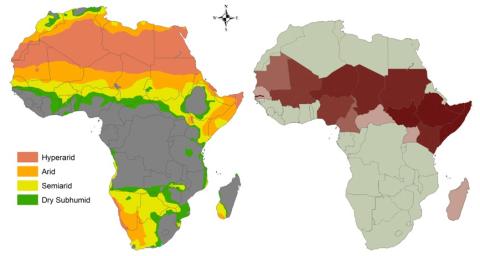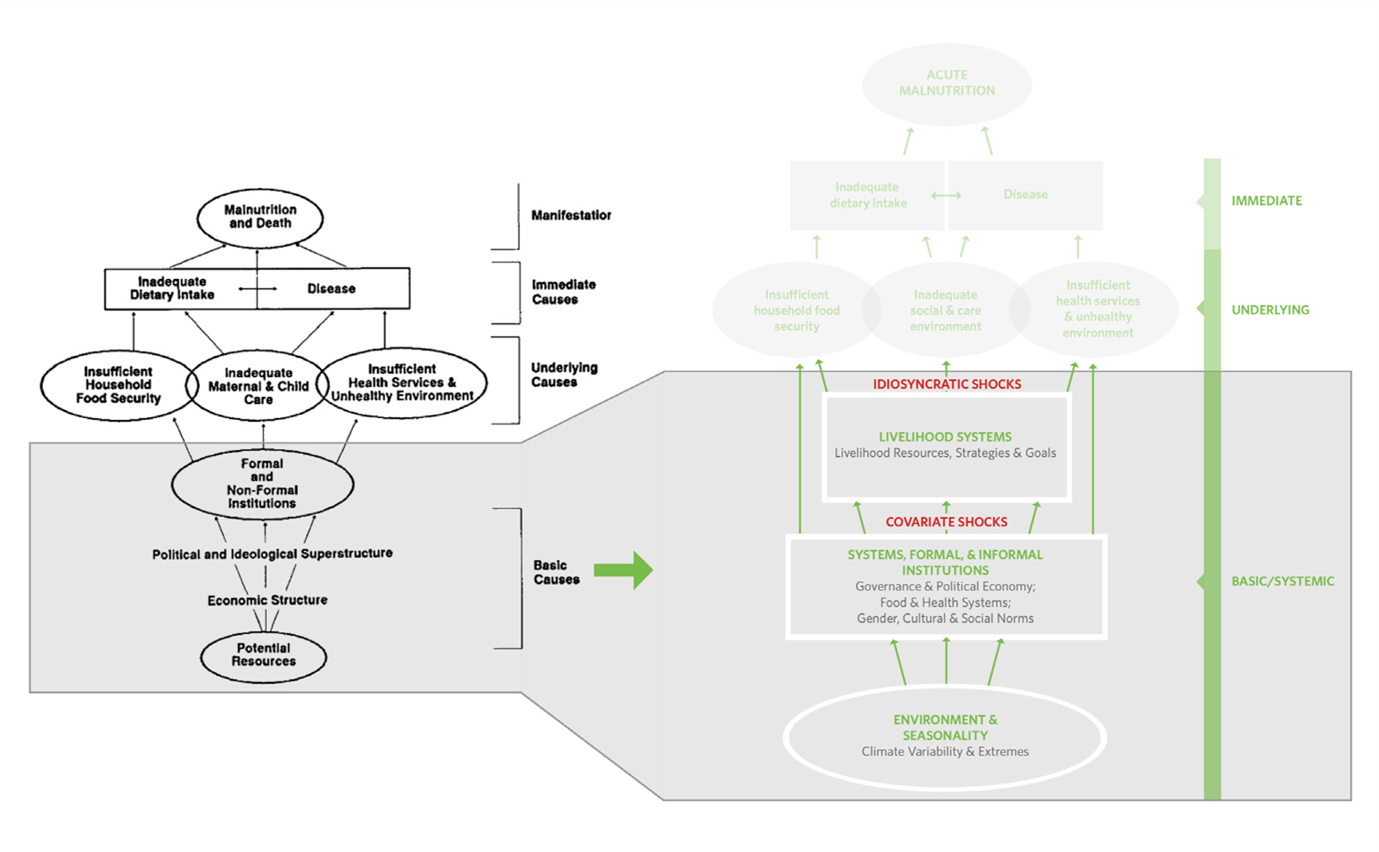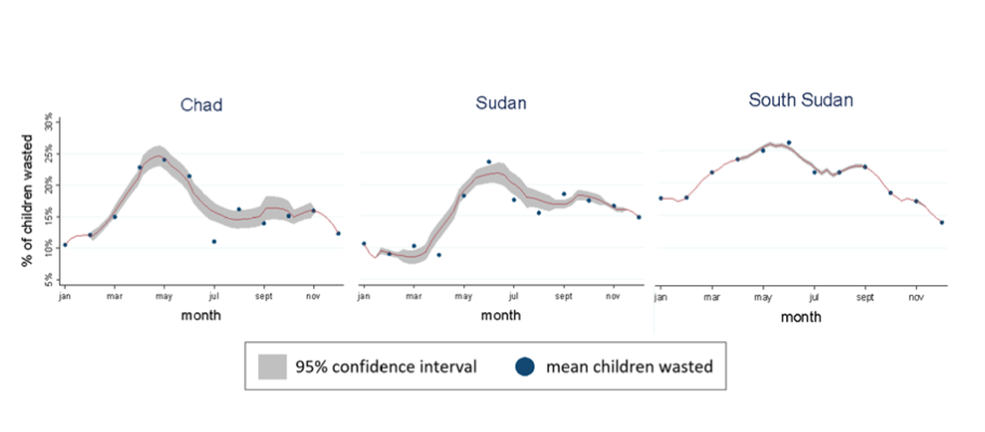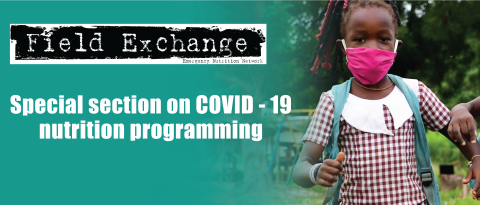Improving the way we address acute malnutrition in Africa’s drylands
Helen Young is a Professor at the Friedman School of Nutrition Science and Policy, Tufts University where she directs Feinstein’s Research Program on Nutrition, Livelihoods and Conflict. Over the past 35 years, her research has contributed to practical guidelines, policy changes, institutional learning and capacity development.
Abdal Monium Osman, Ph.D., is currently a senior emergency and rehabilitation officer at the Food and Agriculture Organization (FAO) of the United Nations. From 2014 to 2017 he worked as FAO Head of Programme in South Sudan.
Anne Radday is the focal point for research communications and knowledge management at the Feinstein International Center, Tufts University. She has more than 15 years of experience in marketing and communications, knowledge management, knowledge product development, organisational strategy and external relations.
Dr. Marshak is a Senior Researcher at the Feinstein International Center at Tufts University. She has over 10 years of experience working in humanitarian contexts with a focus on study design and methods, evaluating impact on nutrition and food security outcomes.
Emmanuella Olesambu is a Programme Officer working on Disaster Risk Management in Ethiopia with the FAO, previously serving as an Emergency and Rehabilitation Officer in FAO’s headquarters in Rome. She has engaged in the field of resilience, natural resource management, livestock and pastoral and drylands development for well over two decades, mainly in Africa.
This article draws on findings from projects funded by the Food and Agriculture Organization of the United Nations, the Dignitas Foundation and the USAID Center for Resilience.
Location: Africa’s drylands What we know: High levels of persistent global acute malnutrition (P-GAM) are a problem across the Sahel and Horn of Africa which are typically dryland regions. What this article adds: An adapted conceptual framework for analysing and addressing acute malnutrition in Africa’s drylands has been developed by Tufts University based on research by Tufts and the Food and Agriculture Organisation (FAO), discussed by a wide group of stakeholders during a series of technical webinars and a roundtable meeting in 2020. The framework acknowledges that the immediate and underlying causes of acute malnutrition depicted in the UNICEF conceptual framework remain relevant but proposes three new interlinked basic drivers: environment and seasonality (acknowledging recent research that reveals seasonal peaks in acute malnutrition), systems and formal and informal institutions and livelihoods systems. The vulnerability and resilience of communities and their livelihoods to climate, conflict and other shocks are also explicit. The authors argue that three critical shifts are necessary to address P-GAM in Africa’s drylands: a shift in conceptual thinking that emphasises the basic drivers of malnutrition in Africa’s drylands, a shift in policy at national level following the lead of the UN Global Action Plan on Child Wasting and a shift in approach that operationalises the adapted framework. This must be underpinned by research and learning on the basic drivers of acute malnutrition using innovative mixed methods and inter-disciplinary approaches with researchers actively engaging with stakeholders to share evidence, learn and build consensus on solutions. |
Introduction
Child acute malnutrition is an increasing global public health problem. For some years, nutrition professionals have acknowledged that emergency rates of global acute malnutrition (GAM), a measure of child wasting, are persistently re-occurring, even in the absence of an obvious emergency and despite ongoing interventions (Young and Marshak 2018). Persistent global acute malnutrition (P-GAM) is particularly evident across the Sahel and Horn of Africa, much of which is typically dryland region (Figure 1). More broadly, the 2020 United Nations (UN) Global Action Plan (GAP) on Child Wasting (WHO, FAO et al. 2020) acknowledges this problem and the need to increase efforts to prevent child wasting as part of the Sustainable Development Goals (SDGs).
Since 2017, the Food and Agriculture Organisation (FAO) and Tufts University have been investigating the problem of acute malnutrition and livelihoods in protracted crises in Sudan, Chad and South Sudan (Young and Marshak, 2019). Building on this earlier research, in 2020 Tufts proposed an adapted framework for analysing and addressing acute malnutrition specific to Africa’s drylands. This was presented and further refined through a series of technical webinars in 2020 and a roundtable meeting with the UN GAP agencies and their resource partners.
This article reflects on the discussions held during the technical series and roundtable meeting, covering the unique context of Africa’s drylands, the three interlinked basic causes of acute malnutrition in this context, the adapted conceptual framework and recommendations for how we can change the way the international community addresses acute malnutrition to better address the problem of P-GAM in this region.
Figure 1: Comparison between Africa dryland areas and countries in East Africa and the Sahel where P-GAM is reported

a. Africa Dryland Areas. Source: Sorensen, 2007
b. Countries in East Africa and the Sahel where P-GAM is reported. Source: Young and Marshak, 2018
Understanding Africa’s drylands
Africa’s drylands are characterised by low-lying arid and semi-arid areas inhabited mainly by pastoralist and agro-pastoralist communities whose production systems have evolved to adapt to these harsh environments. Climate variability is extreme, rainfall erratic and seasonal temperatures reach as high as 40 or 50oC.
Africa’s drylands are facing multiple challenges. Insecure access to farmland, pastures, water and forest resources is threatening livelihoods that are predominantly based on these same natural resources. Increasing competition and the appropriation of natural resources have led to growing conflicts between resource users which are often overlaid by or interconnected with wider conflicts (inter-tribal, rebel insurgencies, cross border etc.). Population growth, migration and displacement are contributing to rapid demographic and social change, accompanied by increasing livelihood diversification and transformation that often renders women and youth in particular dependent on marginal low return activities. Climate change has been associated with the increasing frequency of drought and floods and increasing temperatures in the Sahel. The institutions that should be able to mitigate these challenges and support livelihoods and good nutrition are often weak and under-resourced. These factors have contributed to the increasing scale of humanitarian crises in the drylands and unprecedented donor expenditure.
An adapted conceptual framework to understand the drivers of acute malnutrition in Africa’s drylands
Since the 1990s, there has been broad agreement on a conceptual framework to describe the causes of malnutrition (Figure 2 - left). This framework has three levels: immediate causes, underlying causes and basic causes. Linked with the causal framework, and specifically the immediate and underlying causes, is a set of technical interventions that have become widely advocated and adopted over the past 20 years (Bhutta, Das et al., 2013).
Figure 2: Original UNICEF framework (left) compared with the proposed updated framework (right) in which only the basic causes are changed.

Inadequate food intake and disease are the direct causes of child acute malnutrition which, in turn, are driven by factors related to food, health and care at household and community levels. Implicit in this downstream focus on the immediate and underlying causes of malnutrition is the assumption that part of the solution to child acute malnutrition lies within the agency of communities and households. However, it is critical that we also look upstream to the basic drivers to better understand the social and economic systems and institutions that have such powerful influences on acute malnutrition and its proximal causes. A failure to give attention to these more structural, basic drivers of acute malnutrition accounts for the persistence of acute malnutrition (Gillespie, Haddad et al., 2013; Brown, Backer et al., 2020). If we are to develop more effective approaches to effectively prevent acute malnutrition, it is critical that we co-develop our understanding of these basic drivers and how they work.
The adapted conceptual framework (Figure 2 - right) acknowledges that the immediate and underlying causes remain relevant but proposes a new framework for understanding the basic drivers of acute malnutrition, drawn from the evolving body of knowledge and experience in relation to disaster vulnerability, dryland environments, livelihood systems and resilience. Building on the original framework, the revised version conceptualises the following three interlinked basic drivers: environment and seasonality, systems and formal and informal institutions and livelihood systems. The vulnerability and resilience of communities and their livelihoods to climate, conflict and other shocks are also explicit.
Understanding the three basic drivers of acute malnutrition
Environment and seasonality
Environment and seasonality are underpinned by our understanding of dryland systems as ecosystems with particular characteristics. Dryland regions are characterised by extreme variability in rainfall and vegetation in space and time. So, although there are predictable seasons, there is wide variability from year to year and between nearby areas. For example, when the rains start, where the rain falls and the duration and intensity of the showers varies widely which means the availability of water and pastures is to some extent unpredictable as is the crop growth cycle.
The FAO and Tufts research reveals the importance of seasonality in relation to dryland livelihoods. A re-analysis of 350 surveys from Chad, Sudan and South Sudan found two seasonal peaks in acute malnutrition: the first and larger peak at the end of the hot dry season, as the rains start, and the second peak coinciding with the end of the rains and the beginning of the harvest season (Figure 3).
Figure 3: Prevalence of acute malnutrition (wasting) across months (Chad, Sudan and South Sudan)

Source: (Young and Marshak, 2019)
Additional Tufts’ work has confirmed the relationship between these climatic variables and multiple yearly seasonal peaks in acute malnutrition using both primary data collection in Chad as well as 15 years of secondary data across all unimodal dryland contexts in Africa (Marshak, Venkat et al., 2021).
In 2014, the World Health Organization (WHO), UNICEF and the World Food Programme (WFP) recommended developing “a better understanding of the major causal factors of wasting, including seasonal patterns” (WHO/UNICEF/WFP, 2014). They emphasised the importance of prevention strategies leading up to the lean/hungry periods and the scaling up of treatment services in response to seasonal “surges” of acute malnutrition. Yet, as the FAO/Tufts research on seasonality shows, the timing of seasonal peaks may differ markedly from that which is widely assumed, underlining the urgent need for evidence to support sustainable and appropriately timed solutions for the prevention of acute malnutrition.
Systems and institutions
Systems and institutions determine how things work and influence people’s access to resources. Systems include governance, political and economic systems, food systems, public health systems and livelihood systems. Formal and informal institutions are embedded within systems and reflect agreed ways of working or living together. Formal institutions include policies and formal rules and regulations, such as the regulations governing the quality of the food supply.
Informal institutions reflect widespread and persistent patterns of behaviour and practices that are structured by the norms and values of society. For example, deeply held gendered social norms shape the roles and responsibilities of women, men, girls and boys at household and community level, including access to and control over resources and participation in decision-making in community affairs and politics. The voices and concerns of women, youth and other marginalised groups are often excluded from local decision-making fora. These social determinants of power and control have a powerful influence on the nutrition of children and women.
The climate and conflict shocks that drive acute malnutrition, as well as the social and economic inequities that drive the underlying causes of acute malnutrition, can be potentially mitigated (or exacerbated) by deeper structural and institutional processes. For this reason, a lasting and sustainable impact on acute malnutrition can only be sustained through systemic and institutional change that reduces inequities and positively influences access to the wide-ranging resources necessary for sustaining livelihoods (including human, social, natural, economic and physical resources).
Livelihood systems
The predominant livelihoods in drylands are pastoralism, agro-pastoralism and farming which have long since adapted to the environmental variability affecting the distribution of water, pasture, forest and crops. Dryland producers are expert in managing this variability, knowing where the best conditions can be found for herds or for farming at different times of the year (Krätli, 2015). This specialised livelihood adaptation accounts for the inherent resilience of pastoralism. However, the ways in which dryland producers manage risk are not always well understood and can be inadvertently undermined by inappropriate policies or programmes.
Worsening conditions linked to shocks, combined with poor governance, have undermined livelihood resilience and prompted coping strategies that have led to the transformation of livelihoods, often to the disadvantage of women who bear most responsibility for the nutrition of children.
Attention to livelihoods sharpens the focus on household priorities and local agency – two factors which are often missed by remote programming or ignored by top-down aid delivery approaches. By incorporating livelihood systems and institutions as part of the malnutrition causality framework, recognition is given to inequalities in access to all forms of resources (not only wealth), as well as the importance of wider forms of institutional agency and power that maintain inequalities or marginalise certain groups (as in structural racism).
Developing a new approach to addressing acute malnutrition in drylands
The 2020 UN GAP framework calls for radically improved solutions and “a crucial policy shift” towards prevention and a more sustainable systems-wide approach. The framework is intended to facilitate countries that are most affected by acute malnutrition to develop their own operational roadmaps with “context- specific commitments, targets and actions to accelerate progress and contribute to reaching the global SDG targets” (WHO et al, 2020). The Tufts/FAO technical series concluded that three critical shifts are necessary to address P-GAM to make this happen:
1. A shift in conceptual thinking that emphasises the basic drivers of malnutrition that are specific to Africa’s drylands
Addressing P-GAM in Africa’s drylands is a very specific and pressing problem that can no longer be seen as an aberration linked to humanitarian emergencies. It is now well proven that unacceptably high levels of acute malnutrition have persisted over years, if not decades, in many countries. The scale and severity of this problem justifies further analysis of its long-term trends and drivers, in particular the basic drivers. This must start with an appreciation of environmental variability and seasonality and the way this is managed on the one hand by the prevailing formal and informal institutions and on the other by dryland producers whose livelihoods are fundamentally adapted to these harsh dryland conditions. In addition, the resilience of dryland livelihood systems has been undermined by multiple processes and institutions such as centralised decision-making that ignores local priorities, regulations that restrict herd mobility and processes of land privatisation that limit women’s access to cultivable land or access to water. A new conceptual framework, as presented in Figure 2 - right, will support the generation of new evidence to inform more effective strategies.
2. A shift in policy at national level following the lead of the 2020 UN GAP
The UN GAP on Child Wasting recognises the limitations of technical fixes or interventions and emphasises instead the need for systemic and institutional change, for example strengthening systems that can contribute to improved food, health and social systems. This recognition of the limitations of current approaches is a transformation in public policy and requires systemic change at every level of public office for real change to happen. Concurrent policy changes are needed across multiple sectors at all relevant levels to ensure a conducive policy environment to effect change.
3. A shift in approach that operationalises the adapted framework
While there has been considerable progress on the shift in conceptual thinking and international policy shifts, the greatest challenge lies in developing and operationalising a new approach in a specific context. The UN GAP on Child Wasting advocates promoting government leadership committed to building their own multi-stakeholder consensus to achieve the necessary systemic changes and impacts at the local level. Government commitments and ownership of prevention strategies should be evident in their operational roadmaps.
Developing these roadmaps must include demand-led, applied research to understand the drivers of acute malnutrition, including the basic drivers, as well as monitoring systems for capturing long term trends in acute malnutrition and confirming seasonal patterns of malnutrition and its drivers. Without solid evidence, countries will face challenges building a stakeholder consensus regarding the specific seasonal drivers and the most cost-effective and sustainable approaches to addressing these.
Attention to systemic and institutional approaches requires commitments and buy-in from a diverse cast of players. Such commitments cannot be assumed and neither can the identities of the key players or stakeholders. Studies must identify key stakeholders at all operational levels, starting at the local level in order to comprehend local perspectives, knowledge and understanding as well as their capacities and ongoing commitments. Key stakeholders will include a range of governance and non-state institutions with local institutions that influence people’s lives and livelihoods being particularly important.
Research and learning should underpin new approaches. While impact studies will always have a role to play, researching the basic drivers of acute malnutrition requires innovative mixed methods and inter-disciplinary approaches.
A proper stakeholder analysis combined with an analysis of P-GAM trends, potential hotspots and drivers and seasonal patterns in those drivers and nutrition outcomes can provide an excellent starting point for developing such an operational roadmap and designing evidence-based strategies to prevent malnutrition. Given the potential complexity of this task, it should be approached as a capacity-building exercise ensuring the active participation of key stakeholders in the analysis and in developing the roadmaps. Fortunately, research and learning provide an excellent basis for collaboration, capacity-building and developing local leadership and ownership of evidence.
Conclusion
Much was learned during the technical webinar series and roundtable discussion from the wide audience participation, inputs from panellists and moderators and also from the UN representatives and resource partners. Particularly striking was the acknowledgement at the highest level that business as usual is not working. As one senior commentator remarked, “the historical emergency/humanitarian entry point into wasting has resulted in an overemphasis on services and programmes, rather than on systems, national networks and institutions”. At the same time, panellists spoke authoritatively about the basic systemic drivers, how they play out and how they might be addressed in a more sustainable way. Through these discussions, it became clear that there is no blueprint for multi-systemic strategies and response. This means that researchers cannot simply write research papers and interact mostly with other researchers. We must continue the positive shift towards ‘engaged scholarship’ in which scholars and researchers actively seek out stakeholders, share evidence, listen and learn and together promote collaborative learning and consensus building regarding systemic solutions to acute malnutrition. While there is much more work to be done, this marks a significant shift in approach that we aim to continue as we work toward operationalising the adapted framework.
For more information, please contact Helen Young at helen.young@tufts.edu
References
Bhutta, Z A, Das, J K, Rizvi, A, Gaffey, M F, Walker, N, Horton, S, Webb, P, Lartey, A and Black, R E (2013) "Evidence-based interventions for improvement of maternal and child nutrition: what can be done and at what cost?" The Lancet 382: 452-477.
Brown, M E, Backer, D, Billing, T, White, P, Grace, K, Doocy, S and Huth, P (2020) "Empirical studies of factors associated with child malnutrition: highlighting the evidence about climate and conflict shocks." Food Security 12: 1241–1252.
Gillespie, S, Haddad, L, Mannar, V, Menon, P and Nisbet, N (2013) "The policies of reducing malnutrition: building commitment and accelerating progress." The Lancet 382(9891): 552-569.
Krätli, S (2015) Valuing variability. New perspectives on climate resilient drylands development, IIED. Edited by de Jode, H.
Marshak, A, Venkat, A, Young, H and Naumova, E N (2021) "How seasonality of malnutrition is measured and analyzed." International Journal of Environmental Research and Public Health.
WHO, FAO, UNHCR, UNICEF and WFP (2020) Global Action Plan on Child Wasting. A framework for action to accelerate progress in preventing and managing child wasting and the achievement of the Sustainable Development Goals.
WHO/UNICEF/WFP (2014) Global nutrition targets 2025: wasting policy brief (WHO/NMH/NHD/14.8). Geneva, World Health Organization.
Young, H and Marshak, A (2018) Persistent Global Acute Malnutrition. A discussion paper on the scope of the problem, its drivers and recommendations for policy, practice and research. A Feinstein International Center Publication. USA, Feinstein International Center, Tufts University.
Young, H and Marshak, A (2019) Twin peaks: The seasonality of acute malnutrition, conflict and environmental factors in Chad, the Sudan and South Sudan. Rome, Food and Agriculture Organization of the United Nations.


